Dazhao Temple Scenic Area in Lhasa
Dazhao Temple, also known as "Zula Kang" and "Jue Kang" (Tibetan meaning for Buddhist temple), is located in the center of the old city of Lhasa. It is a Tibetan Buddhist temple built by Songzan Ganbu, the Tibetan king. The reason why Lhasa has the reputation of "holy place" is related to this Buddha statue. The temple was originally called "Lhasa", and later it became the name of the city and evolved into the current "Lhasa". After the completion of the Dazhao Temple, it was revised and expanded repeatedly in the Yuan, Ming and Qing dynasties to form its present scale.
Dazhao Temple has a history of more than 1300 years, and has the supreme position in Tibetan Buddhism. Dazhao Temple is the most brilliant building in Tibet during the Tubo period, and the earliest civil structure building in Tibet. It also initiated the Tibetan-style temple-city regulation. The circle of Sakyamuni Buddhist Hall in the inner center of Dazhao Temple is called "Bakuo". The circle of the outer wall of Dazhao Temple is called "Bakuo". The Street radiated from the outside of Dazhao Temple is called "Bakuo Street", that is, Bajiao Street. Taking the Dazhao Temple as the center, a large circle of Potala Palace, Yao Wang Mountain and Xiaozhao Temple is called "Lin Jie". The three rings from the inside to the outside are the routes of the Tibetan people's ritual of traveling through Buddhist scriptures.
The Dazhao Temple, which combines Tibetan, Tang, Nepalese and Indian architectural styles, has become a thousand classical models of Tibetan religious architecture. The incense in front of the temple is burning all day, and the devout worship of the followers left deep impressions of equal length on the bluestone floor in front of the temple. Thousands of butter lamps are bright, leaving traces of time and pilgrims.
Main building
The Dazhao Temple Hall is four stories high. The whole building has a typical Han style of golden roof and dome arch. Diaolou and Diaoliang are Tibetan styles. There are 103 wooden carved animals and lion bodies arranged in rows under the eaves of the second and third storeys of the main hall. There are Tibetan murals of nearly 1000 meters in length, Wencheng Princess's Entry into Tibet, and Dazhao Temple's Construction.
Maitreya Temple
The main worshipper of the temple is a small and delicate statue of Maitreya Buddha. In the past, the statue was carried and paraded along Baku Street every year during the calling of the Great Law Society. A statue of Manjusri Bodhisattva and a statue of Guanyin Bodhisattva are separated on the left and right sides of the statue, and beside the two statues of Bodhisattva is another statue of Tara. In addition, the four angry Dharma gods on the wall guard the temple. On the right side of the door is the King of Owen (one of the four heavens), and on the left is the God of wealth, Janbala. On the altar was a shabby statue of the Jewabum Lama, who had built a dam in Lhasa to protect Lhasa from flooding. If you look carefully at the lower left corner of the Buddhist Hall when you enter, you will see a small stone goat. This is the legendary sacred sheep backfilling the pond lake.
The Guanyin Bodhisattva Hall
The main worshipper of the Buddha Hall is a small statue of Guanyin Bodhisattva (the first one on the left) riding on a lion, rather than the great Lightless Buddha. The remaining five statues are different incarnations of Guanyin Bodhisattva. On the wall between the Buddha Hall and the staircase leading upstairs, there is a pillar with a hole on the top. Many pilgrims hold their ears close to this heir hoping to hear the sound of ducks flapping their wings. According to legend, this duck is stored in the bottom of Wotang Lake in Dazhao Temple.
The Palace of the Three Fathers
Duma Hall
Tara Mother Hall, the Buddhist Hall is dedicated to Tara Mother. The great Buddha statue in the center of the palace is the Tara Mother. In the glass cabinet behind her, it is her main incarnation of the "Twenty-first Mother". On the right side of the niche are six Buddha statues. The first three are a group of Buddha statues known as the "Three Masters and Princes". They are the Buddha statues of Kumbu, the Lotus-peanut Rail Model Master and the Dharma King Chisong Dezan. The other three are "three masters and three apprentices", namely, Master Zongkaba and his two disciples Kezhongjie and Jia Caojie.
The Tang and Tibetan Union Monument
Entering the small square in front of Dazhao Temple, you can see the whole picture of Dazhao Temple. First came the two stone tablets enclosed by the wall. On the south side is the famous tablet of the Tang and Fan Hui League, which is 3.42 meters high, 0.82 meters wide and 0.35 meters thick. The three years of Tang Changqing (823 A.D.) were written in Tibetan and Chinese.
In the 9th century, the Tang Dynasty and the Tubo Dynasty made peace with each other in order to achieve the goals of "not being enemies, not lifting up military reforms", "making the people peaceful, thinking as one" and "revering nephew's kindness forever". In order to show the sincerity of friendship between the two peoples for generations, Zampuchi Dzuzan set up this monument in front of the Dazhao Temple. The inscription is simple and unadorned, and the words are sincere. The monument has been decorated, and most of the inscriptions are still clear and discernible. Next to the stele is a willow tree, which is said to have been planted by Princess Wencheng herself. The local people call it Princess Willow.
Tang Tubo League Monument is also called Nephew Union Monument, because Tubo Zanpu Chide Zu praised the princess of the Tang Emperor, so naturally his children will call the later Tang Emperor Uncle.
Zongkaba and his eight disciples'Hall
This Buddhist temple was built in memory of Zongkaba, the founder of the Gelug School. In the center of the Buddhist temple, Zongkaba is the main venerator. The other eight are his eight disciples. The two most famous disciples, Kezhujie and Jia Caojie, are located on the left and right sides of the statue of Zongkaba. As Zongkaba grew older and grew into a remote cave, the eight disciples had accompanied him around and served him. When Zongkaba was alive, his disciples funded several statues of him. It is said that when Zongkaba saw the statue, he appraised it as a special image of himself. Another way of saying is that this Buddha statue was magically made by the Buddhist God Yan Luo. Another theory is that the Buddha statue was made by a later Mongzan emperor. On the left side behind the Zongkaba statue is a row of statues of his Sakya teachers. Under the stairs of this Buddhist temple is a trapdoor leading down to the lake below. The Falun Palace of Yonghe Palace in Beijing also supports this master.
God-transformed Tower
In the 7th century, Songzan Ganbu threw the ring into the air to determine the site of the Dazhao Temple. The ring fell into Wotang Lake, and a phantom white pagoda rose from the lake, indicating that a suitable Temple site had been found. In the 13th century, Sakya Banzhida built a white pagoda in the form of a phantom white pagoda. Later, the pagoda was destroyed and the main seat was rebuilt to replace the white pagoda built by Sakya Banzhida.
Eight Pharmacists Buddhist Hall
The main hall is dedicated to eight pharmacists who are respected as gods of medicine. When they are sick or praying for physical well-being, believers believe that worship of this Buddhist temple can help them get rid of illness and strengthen their health.
The Buddha Hall of Infinite Light
The entrance to the temple is guarded by two angry guardians. On the left is the blue vajra-hand Bodhisattva, and on the right is one of the red horse-head Ming Kings, Toulimaiwatsgaba. In the Buddhist temple, the Lord's Infinite Light Buddha is flanked by two small angry gods protecting the Dharma. On both sides of the wall, there are four shabby Buddha statues. This Buddhist temple is sometimes called the "Hall of Karma". Because this Buddhist temple is close to the temple of Sakyamuni, believers pray here to remove obstacles to their worship of Sakyamuni.
Lotus Peanut Buddhist Hall
In a corner under the stairs are two statues of lotus and peanut, and on the right is a statue of the Tibetan King Chi Shide. When you leave this temple, you will see a statue of Sakyamuni enclosed by an iron fence on the left wall. It is said that this is the place where Nine Tai Bodhisattvas manifest themselves.
The main dignity of the Buddhist temple is Songzan Ganbu, the Tibetan King, on the left, Chisong Dezan, and on the right, Chizu Dezan, the Tibetan King. These three Tibetan kings were in power at the peak of the Tubo period. With their strong support, Buddhism was able to spread to Tubo and flourish here. They are the three Fa Kings in Tibetan history. Traditionally, they are known as "Three Fa Kings of ancestors and grandchildren".
Bandaram Temple
Bandaram Temple is located between the second and third floors. The statue of Bandaram on the throne is a blue and black goddess of majesty. It is the goddess of protection in Dazhao Temple and the whole city of Lhasa.
Jinding of Dazhao Temple
At the bottom ticket office, there are stairs leading to the platform on the second and third floors. Overlooking from the platform: The buildings of the Potala Palace shine in the bright sunshine. Looking down, you can see the flow of people in Dazhaoshi Square and Bakuo Street, which is full of Tibetan life. There are also teahouses here in summer, where you can rest.
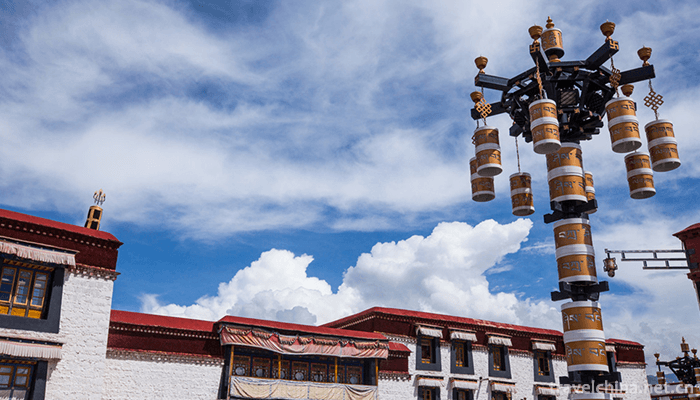

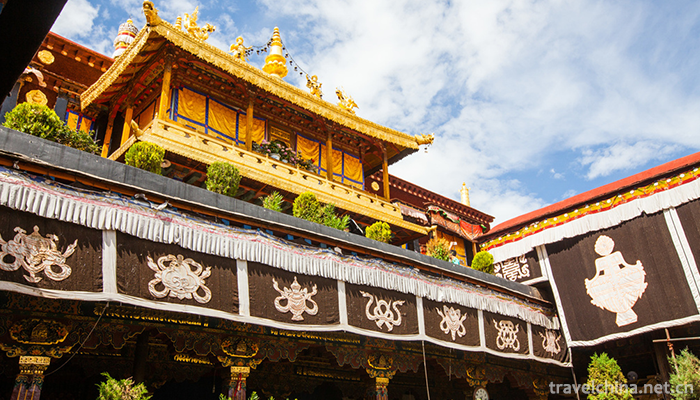
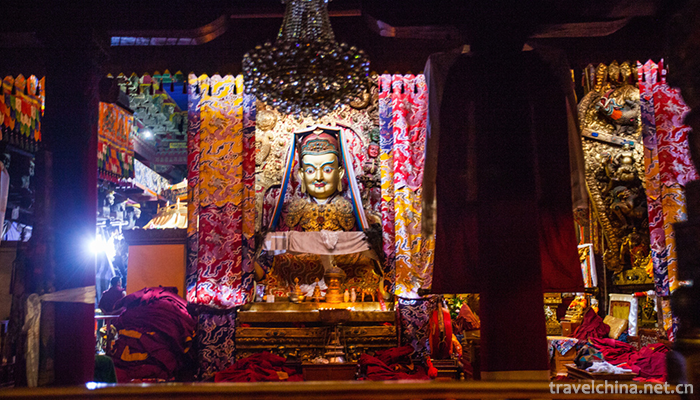
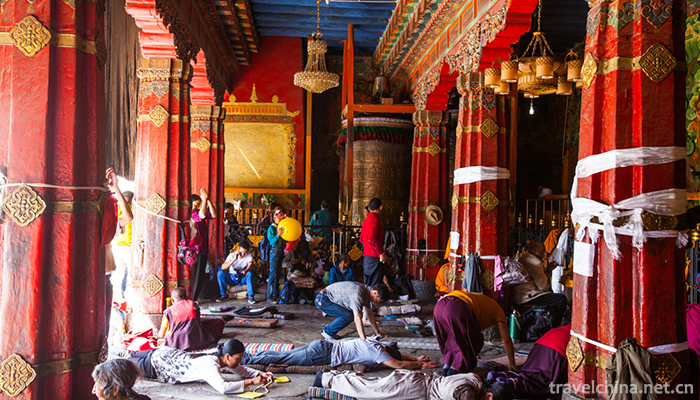


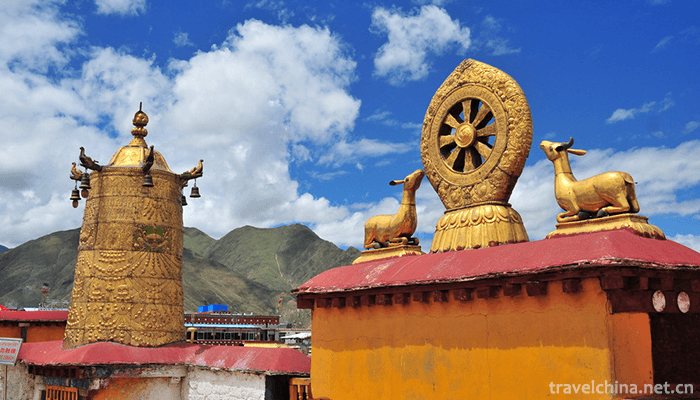
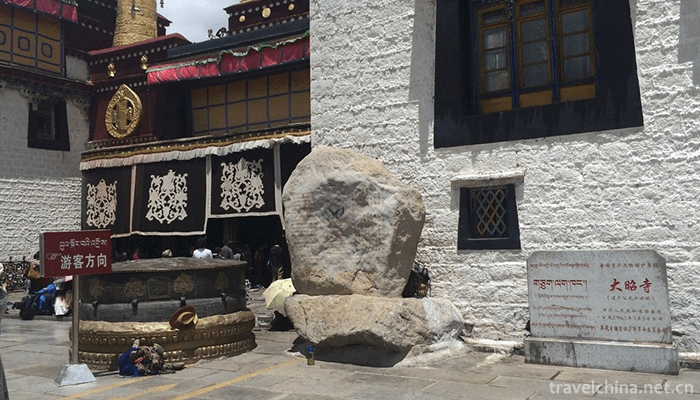

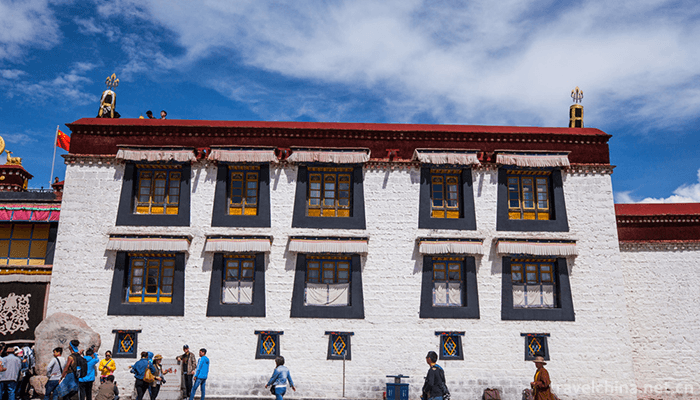
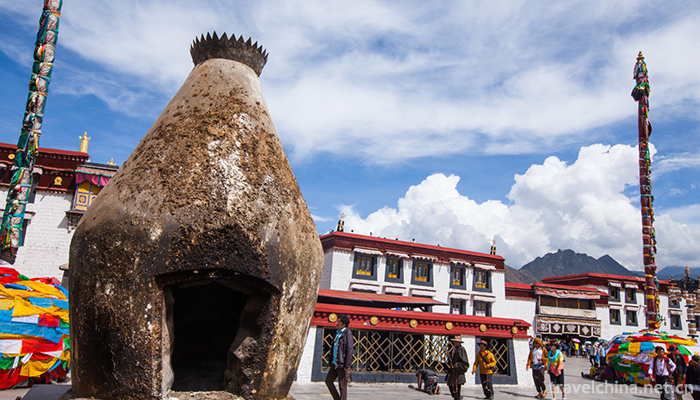

-
1.Lang Mountain Scenic Area
Langshan is located in the northwest side of the hinterland of the Yuechengling Mountains, which is the longest in Wuling Mountains. It spans Xinning County and Resource County
Time 2018-12-12 -
2.Guyuan Museum
Guyuan Museum of Ningxia was established on December 30, 1983. It belongs to the Cultural Office of Ningxia Autonomous Region. It is located at No. 133 Xicheng Road, Guyuan City, southern mountain are
Time 2019-01-12 -
3.Beijing embroidery
Beijing embroidery, also known as palace embroidery, is an ancient Chinese traditional embroidery technology, the general name of embroidery products centered on Beijing. Ming and Qing
Time 2019-05-07 -
4.Meishan Wushu
Meishan Wushu is a traditional school of Wushu which is spread in Hunan Province. Xinhua is an ancient and magical land. It has not only nurtured many historical celebrities, but also cultivated Meish
Time 2019-06-03 -
5.Shaoxing Xuanjuan
Shaoxing Xuanjuan is a traditional rap art with religious color, which is mainly used to worship gods and pray for blessings. Since Tang Dynasty, it has developed into folk art in Qing Dynasty. The So
Time 2019-06-14 -
6.She nationality novel song
She nationality novel song originated from Bailukeng Village, Xinan Town, Xiapu County, Fujian Province. It was adapted and created by She nationality folk singers according to their national living c
Time 2019-06-14 -
7.Suona Art
Suona art is a manifestation of traditional Chinese folk culture. In 2006, Qinyang City of Henan Province and Qingyang City of Gansu Province applied for intangible cultural heritage. Its basic musica
Time 2019-06-17 -
8.Make a chant
Bamboo and hemp trumpet is a traditional folk song of Qionglai City, Sichuan Province. It belongs to a kind of labor trumpet sung by local papermaking workers when playing bamboo and hemp. It is mainl
Time 2019-08-03 -
9.Advertising for rent
There are six advertising spaces for each article, first come, first served.
Time 2019-08-30 -
10.University of International Relations
University of International Relations (University of International Relations), referred to as "Guo Guan", is located in the western suburb of Beijing. Ministry of Education of the People's R
Time 2019-09-22 -
11.China Agricultural University
China Agricultural University (China Agricultural University), referred to as "China Agricultural University", is located in Beijing City By Ministry of Education of the People's Republic of
Time 2019-12-21 -
12.Needlework of Chinese embroidery
Category: random needling, straight needling, disc needling, trowel needling, grabbing needling, flat needling, scattered wrong needling, weaving embroidery, applying needling, auxiliary needling, variant embroidery
Time 2020-12-12